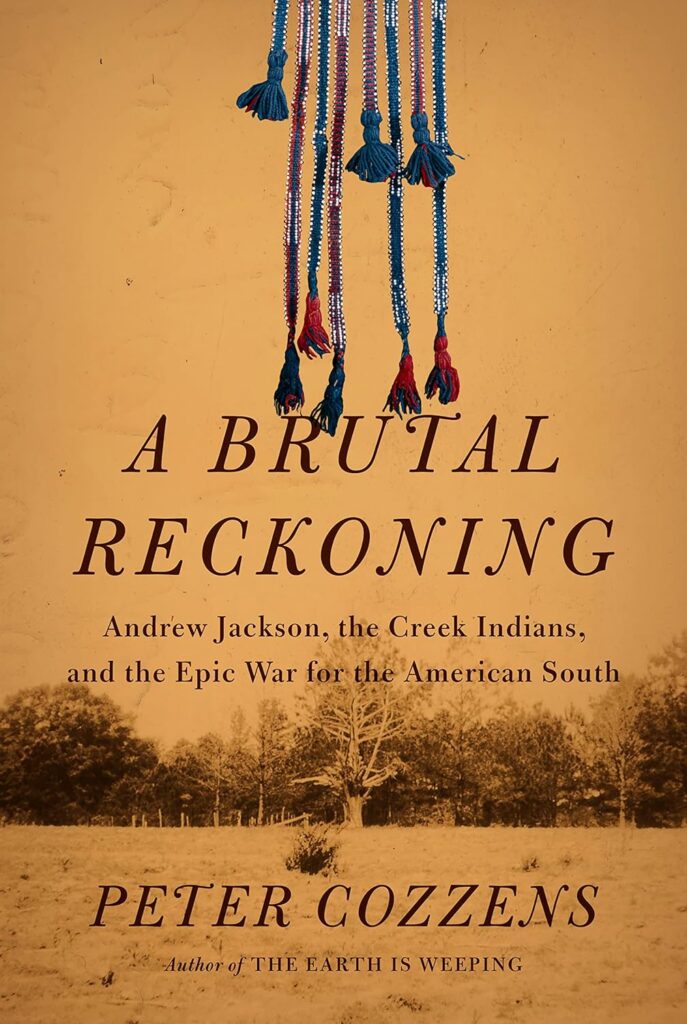In 1841, John Quincy Adams characterized Andrew Jackson’s Indian policy as “among the heinous sins of this nation, for which I believe God will one day bring them to judgment.” History has largely agreed with the sixth president. The destruction of the Indian tribes in the southeastern U.S., as Peter Cozzens argues, was “a brutal reckoning,” one with ramifications for the coming of the Civil War.
Cozzens’ brilliant book begins with a detailed accounting of four Southeastern tribes—the Creeks, Cherokees, Choctaws, and Chickasaws—who descended from the centuries-old Mississippian society and by the mid-18th century together numbered about 70,000. Creek society was organized in towns (talwas) of between 50 and 500, with peaceful (white) and warlike (red) talwas sharply delineated from one another. Each had separate leaders for civil and military affairs.
Early trading partners with English settlers, the Creeks at first sold other Indians into slavery before turning to capturing fugitives once Black enslavement became prevalent. The increasing encroachment on Indian lands by White settlers led the British crown to issue the Proclamation of 1763, forbidding white settlement beyond the Appalachians. This would prove to be the first in a cascade of unsuccessful attempts to forestall the eventual White expropriation of virtually all Indian lands in the Southeast.
During the early republic, Thomas Jefferson’s administration aggressively sought to claim Indian homelands for White settlement. At the same time, the Shawnee chief Tecumseh and his brother Tenskwatawa, the Shawnee Prophet, sought to recruit the Southeastern tribes to a confederation opposing White settlement. Tecumseh’s efforts ultimately fell short, but his brother’s teachings found a receptive audience among “Red Sticks” (named for the traditional Creek war club), who sought a return to traditional tribal ways.
The flashpoint for the Creek War came in August of 1813, when the Red Sticks attacked Fort Mims in Alabama, killing between 250 and 300. When the federal government refused to approve retaliatory strikes by volunteer forces led by Andrew Jackson, the willful commander decided, not for the last time, to proceed against the Red Sticks on his own initiative.
Fort Mims proved to be the only notable victory for the Red Sticks in a conflict that was both brutal and short. By March 1814, Jackson’s troops had killed as many as 2,000 Creeks, about half of the tribe’s able-bodied warriors, in a series of bloody confrontations, some of which are best characterized as massacres. Especially dispiriting for the Red Sticks was the failure of the powers of charms cast by Creek prophets to protect them during battle.
Jackson offered harsh peace terms, demanding the Creek cession of 22 million acres—about half of their tribal lands—and White access to their remaining lands for roads and military forts. The 1814 Treaty of Fort Jackson established a pattern of land seizure and removal that would characterize White–Indian interactions for the remainder of the 19th century.
A small number of Creeks remained unreconciled to their defeat, holding out hope that the British might yet prove to be useful allies. But Jackson’s against-all-odds victory at the Battle of New Orleans in January 1815 ended any further Creek resistance. The Treaty of Ghent sought to undo the Treaty of Fort Jackson, obligating the warring nations to make peace with the Indians and restore the lands they had held in 1811. The Madison administration, however, did nothing to dissuade Jackson from ignoring these obligations.
The end of the War of 1812 and Spain’s cession of Florida to the United States in 1821 unleashed White settlers into the Southeast in numbers heretofore unseen, revivifying cotton planting and chattel slavery. Several treaties in the 1820s and the Indian Removal Act of 1830 foreshadowed the removal of nearly all Indians from the southeastern United States. In July 1836, a total of 14,609 Creeks left for territory west of the Mississippi, and 5,000 more were transported the following year. While there had been more than 23,000 Creeks in 1832, by 1859 their number had dwindled to 13,537.
Cozzens’ narrative is deeply engaging and notably absent any unnecessary hand-wringing or moral outrage. In his final sentence, he adeptly sums up the outcome of his title’s brutal reckoning: “The prosperity that came at the expense of the dispossessed Creeks endured scarcely two decades…before Adams’ avenging God wrought judgment on the usurpers in a great and terrible civil war, a cataclysm from which elderly Creek survivors of the horrors of 1813-1814 might have taken a mordant satisfaction.”

A Brutal Reckoning
Andrew Jackson, the Creek Indians, and the Epic War for the American South
By Peter Cozzens, Alfred A. Knopf, 2023
If you buy something through our site, we might earn a commission.





